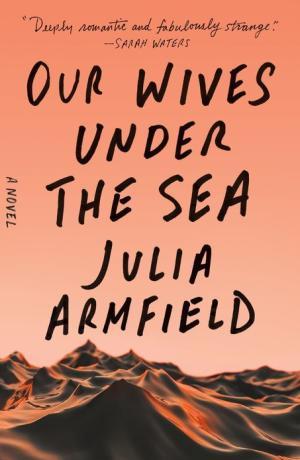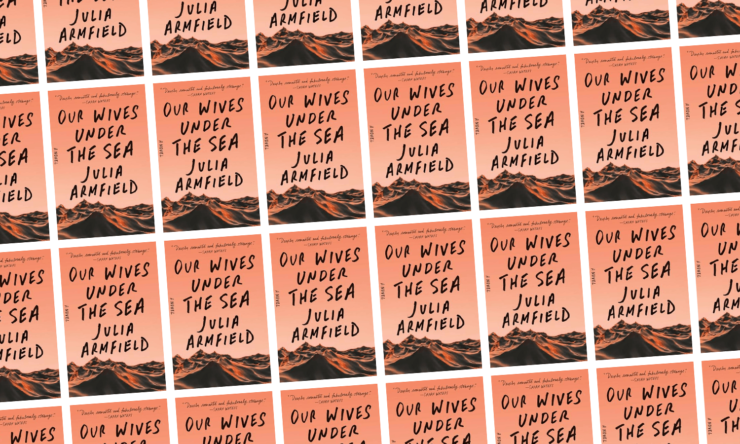In James Cameron’s 1989 classic horror-thriller, The Abyss, the seasoned crew of an experimental underwater oil-drilling platform are reluctantly recruited by the United States Navy to assist a SEAL team in investigating the mysterious sinking of an American nuclear submarine near the Cayman Trench. Led by foreman Bud Brigman (Ed Harris) and his hypercompetent, stubborn estranged wife Lindsey (Mary Elizabeth Mastrantonio), the crew endures a variety of harrowing mishaps before ultimately sending Bud into the titular Abyss to disarm a nuclear warhead. Bud (spoiler alert, I guess?) runs out of oxygen in the trench, sending a final text message as Lindsey weeps: DONT CRY BABY. KNEW THIS WAS A ONE WAY TICKET BUT YOU KNOW I HAD TO COME. LOVE YOU WIFE.
“Knew this was a one way ticket but you know I had to come/love you wife” serves as a tidy résumé of Julia Armfield’s saltwater gothic Our Wives Under the Sea, a haunting and masterfully crafted novel of love, loss, lesbians, and sea monsters.
Its plot is deceptively simple: Miri’s marine biologist wife, Leah, is chosen for a three-week deep-sea-research submersible expedition by a nebulous corporate entity, the Centre, helmed by a mysterious and vaguely Elon Musk-like personage. The mission goes awry, and Leah is trapped in the submersible with her crewmates for six months, presumed dead and unable to communicate with the surface. When she finally comes back, something about her is very different. The narration is split between Miri in the present—frustrated by the hours Leah spends in the bath, her strange and increasing health problems, her uncharacteristic lack of communication—and Leah in the past, at the bottom of the ocean, as the depths slowly reveal their terrifying mysteries.
What is love, after all, but the greatest of all horrors: the mortifying ordeal of being known, as the internet would have it. Like most, if not all, great horror movies—and certainly Cameron’s sole masterpiece, Aliens—The Abyss is as much a romance as it is a creature feature, a story in which the real terror hinges around the fear-filled unknown stealing away the person who knows you best and loves you regardless. Such it is with this novel. “I thought about the day it first occurred to me that, should [Leah] die, there would be no one in the world I truly loved,” Miri says. “You can, I think, love someone for a very long time before you realize this, notice it in the way you note a facial flaw, a speech impediment, some imperfection which, one recognized, can never again be unseen. Are you just now realizing that people die, Leah had said to me when I voiced this thought, tucked up beside her on the sofa with my knees pressed tight into the backs of hers. Not people, I had said, just you.”
Buy the Book


Our Wives Under the Sea
While mermaids and krakens may owe their origins to sailors’ stories of unfamiliar animals seen at sea—the manatee, the dugong, the walrus, the giant squid—some historians have suggested that medieval mapmakers added sea monsters along trade routes both to excite the attention of land-bound viewers and so that merchants could stifle further nautical exploration and establish their own monopolies. The monster is not so much a distraction from capitalism as a requirement of it: “From its position at the limits of knowing,” notes monster scholar Jeffrey Jerome Cohen, “the monster stands as a warning against exploration of its uncertain demesnes. The giants of Patagonia, the dragons of the Orient, and the dinosaurs of Jurassic Park together declare that curiosity is more often punished than rewarded, that one is better off safely contained within one’s own domestic sphere than abroad, away from the watchful eyes of the state. […] To step outside this official geography is to risk attack by some monstrous border patrol or (worse) to become monstrous oneself.”
Monsters have long served as synecdochic stand-ins for unruly bodies—queer, disabled, mad, resistant to colonization. The monster is persecuted for its ungovernability; the monster dies at the end of the story; but the monster demands a sequel, the monster always returns. “Every horror movie ends the way you know it will,” Miri tells Leah. “If you’re watching a movie about werewolves, you can be almost certain your hero will become one by the end.” Miri and Leah’s marriage is transcendently lovely in its ordinariness. Armfield is a master of the resonant textural details of a relationship, a whole life together rendered in stunning particulate. Miri and Leah go on dates at bars, watch silly movies together, build a private history. But their queerness sets them apart regardless, and Armfield is well aware of the ways in which some queer adulthoods—non-child-having, non-home-owning, non-legible to the stultifying strictures of capitalism—are pathologized by the straight mainstream as eternally juvenile, devoid of “real” concerns.
That willful incomprehension is (often hilariously) personified by Miri’s straight friend Carmen—“my best friend, I sometimes worry,” Miri observes drily—who is forever comparing Miri’s loss of Leah to the breakup of Carmen’s own relationship with “Tom,” “a social worker and weekend DJ” about whom Carmen speaks “the way one might refer to a bachelor’s degree: a three-year period one has to endure in order to talk with overbearing authority on exactly one subject. She is the world’s living expert on loving and losing thirty-year-old men named Tom.” All romantic partnerships evolve in a world of their own, a thicket of inside jokes, neuroses, quirks, and shared preoccupations impenetrable to the outside observer. But Carmen’s obliviousness is also particular to Miri and Leah’s queerness. Carmen frequently remarks how “alike” Leah and Miri are, when in fact they are not similar at all. “It occurred to me,” Miri says, “that this perceived resemblance between Leah and myself had more to do with the two of us being women than it did with anything real.” And though Carmen is supportive, in her own way, after Leah’s return, she insists on comparing Leah’s increasing strangeness to her own set of Tom-adjacent referents.
Of course, Leah and Miri haven’t broken up at all. Leah went to work; and then she didn’t come back when she was supposed to; and then when she did she came back wrong. What Miri is left with is a dense and wholly isolating grief that is irresolvable because of its intangibility. Leah is alive and present physically; their relationship continues; but the Leah who came back is not the same Leah who left, and Miri is left in a liminal abyss of her own, wondering if the Leah she fell in love with will ever return.
If that sounds like a metaphor, it is one—for death; for dissolution; for the point near the end of a long-term romantic relationship where the once-beloved becomes a stranger, or even someone loathed—but it’s also literal. As Miri discovers during late lonely nights online, there are no Reddit forums offering advice on how to cope when the love of one’s life is possibly turning into a sea monster and everyone around you has already moved on. The actor inside the first Alien movie’s monster suit was a man named Bolaji Badejo, a six-foot-ten Nigerian graphic design student discovered in a Soho pub by a member of the film crew during its production; Alien was the only movie in which he ever appeared. That is not a metaphor, but it certainly works as one. If the matter of the monster houses that which we fear most, it matters very much who is housed within that we.
As it turns out, the only monsters of The Abyss are human. Bud survives his fall through the depths; at the bottom he finds a civilization of highly advanced alien beings who (depending on whether you’re watching the theatrical release or the extended version) may or may not be considering drowning all of humanity in order to stop us from dropping nuclear bombs on one another. Why haven’t you yet, Bud asks them, and in response they play his last message to Lindsey back for him on a screen they’ve made out of water: LOVE YOU WIFE. Then the aliens bring everyone—Bud, Lindsey, the crew, the wrecked underwater rig—back to the surface, Bud and Lindsey are reunited, and the movie ends. THEYVE LEFT US ALONE BUT IT BOTHERS THEM TO SEE US HURTING EACH OTHER, Bud messages Lindsey on his way back up out of the watery dark.
Our Wives Under the Sea’s heartbreaking and inevitable conclusion offers no such alien solution to our very human harms, but it carries the reader through the horror of loving other people nonetheless.
Our Wives Under the Sea is available from Flatiron Books.
Sarah McCarry is the author of the novels All Our Pretty Songs, Dirty Wings, and About A Girl, the editor and publisher of the chapbook series Guillotine, and the Executive Director of the Eve Kososfky Sedgwick Foundation. Her work has been shortlisted for the Lambda Award, the Norton Award, and the Tiptree Award, and she has received fellowships from the MacDowell Colony, the Joint Quantum Institute, the Launchpad Writers’ Workshop, and The Arctic Circle.










